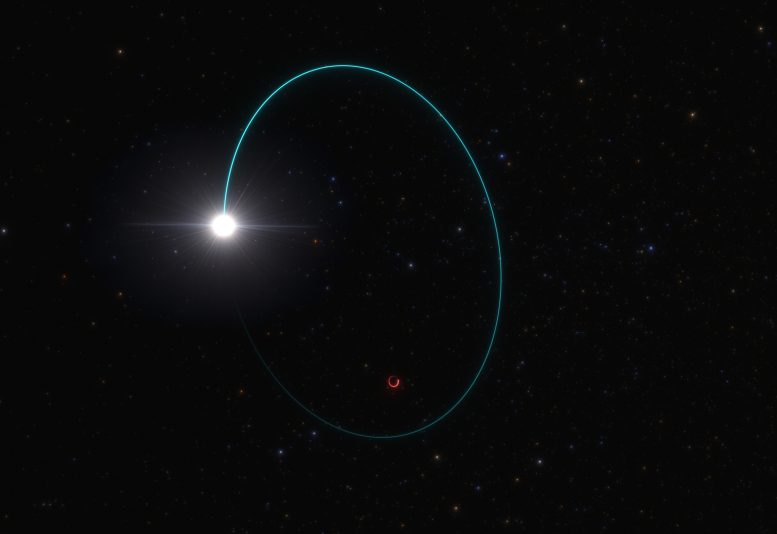
Astronomers have found the most massive stellar black hole in our galaxy, thanks to the wobbling motion it induces on a companion star. This artist’s impression shows the orbits of both the star and the black hole, dubbed Gaia BH3, around their common center of mass. Credit: ESO/L. Calçada
Astronomers have identified a stellar black hole in the Milky Way with a mass 33 times that of the Sun, located only 2000 light-years away.
Astronomers have identified the most massive stellar black hole yet discovered in the Milky Way galaxy. This black hole was spotted in data from the European Space Agency’s Gaia mission because it imposes an odd ‘wobbling’ motion on the companion star orbiting it. Data from the European Southern Observatory’s Very Large Telescope (ESO’s VLT) and other ground-based observatories were used to verify the mass of the black hole, putting it at an impressive 33 times that of the Sun.
Stellar black holes are formed from the collapse of massive stars and the ones previously identified in the Milky Way are on average about 10 times as massive as the Sun. Even the next most massive stellar black hole known in our galaxy, Cygnus X-1, only reaches 21 solar masses, making this new 33-solar-mass observation exceptional.[1]
Remarkably, this black hole is also extremely close to us — at a mere 2000 light-years away in the constellation Aquila, it is the second-closest known black hole to Earth. Dubbed Gaia BH3 or BH3 for short, it was found while the team were reviewing Gaia observations in preparation for an upcoming data release. “No one was expecting to find a high-mass black hole lurking nearby, undetected so far,” says Gaia collaboration member Pasquale Panuzzo, an astronomer from the National Centre for Scientific Research (CNRS) at the Observatoire de Paris – PSL, France. “This is the kind of discovery you make once in your research life.”
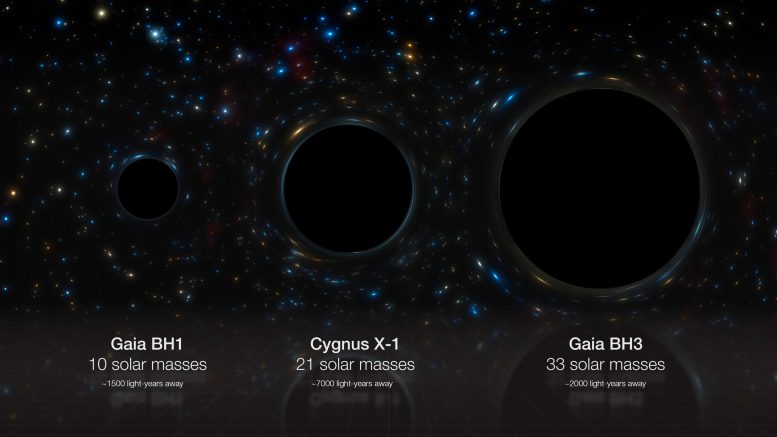
This artist’s impression compares side-by-side three stellar black holes in our galaxy: Gaia BH1, Cygnus X-1 and Gaia BH3, whose masses are 10, 21 and 33 times that of the Sun respectively. Gaia BH3 is the most massive stellar black hole found to date in the Milky Way. The radii of the black holes are directly proportional to their masses, but note that the black holes themselves have not been directly imaged. Credit: ESO/M. Kornmesser
To confirm their discovery, the Gaia collaboration used data from ground-based observatories, including from the Ultraviolet and Visual Echelle Spectrograph (UVES) instrument on ESO’s VLT, located in Chile’s Atacama Desert.[2] These observations revealed key properties of the companion star, which, together with Gaia data, allowed astronomers to precisely measure the mass of BH3.
This video zooms into BH3, the most massive stellar black hole discovered so far in our galaxy. The black hole was detected thanks to the wobbling it induces on a companion star, seen here as a bright point at the center of the frame towards the end of the zoom. An inset at the end of the video shows an artist’s animation of what the orbits of BH3 (in red) and its companion star (in blue) around their common center of mass look like. Credit: ESO/L. Calçada, N. Risinger (skysurvey.org), DSS. Music: Martin Stuertzer
Astronomers have found similarly massive black holes outside our galaxy (using a different detection method), and have theorized that they may form from the collapse of stars with very few elements heavier than hydrogen and helium in their chemical composition. These so-called metal-poor stars are thought to lose less mass over their lifetimes and hence have more material left over to produce high-mass black holes after their death. But evidence directly linking metal-poor stars to high-mass black holes has been lacking until now.
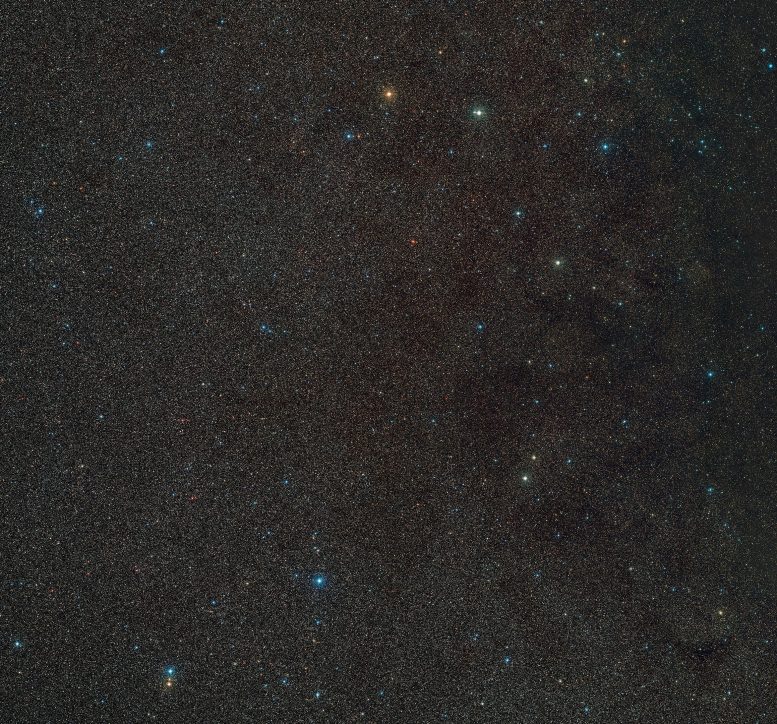
This image shows a wide-field view of the area around Gaia BH3, the most massive stellar black hole in our galaxy. The black hole itself is not visible here, but the star that orbits around it can be seen right at the center of this image, created from photographs of the Digitized Sky Survey 2. Credit: ESO/Digitized Sky Survey 2. Acknowledgment: D. De Martin
Stars in pairs tend to have similar compositions, meaning that BH3’s companion holds important clues about the star that collapsed to form this exceptional black hole. UVES data showed that the companion was a very metal-poor star, indicating that the star that collapsed to form BH3 was also metal-poor — just as predicted.
This artist’s animation, done with Space Engine, shows the locations and distances (in light-years [ly]) to some of our galaxy’s stellar black holes: Gaia BH3, a black hole now found to be the most massive stellar black hole ever identified; Cygnus X-1, the next most massive stellar black hole; and Gaia BH1, the closest black hole to Earth. At the center of our galaxy, lurks Sagittarius A*, a supermassive black hole. Note that, due to a projection effect, Gaia BH3 looks closer to the Sun than Gaia BH1, but in reality the former is further away. It’s the second-closest black hole to Earth identified to date. Credit: ESO/L. Calçada/Space Engine (spaceengine.org)
The research study, led by Panuzzo, is published today in Astronomy & Astrophysics. “We took the exceptional step of publishing this paper based on preliminary data ahead of the forthcoming Gaia release because of the unique nature of the discovery,” says co-author Elisabetta Caffau, also a Gaia collaboration member and CNRS scientist from the Observatoire de Paris – PSL. Making the data available early will let other astronomers start studying this black hole right now, without waiting for the full data release, planned for late 2025 at the earliest.
Further observations of this system could reveal more about its history and about the black hole itself. The GRAVITY instrument on ESO’s VLT Interferometer, for example, could help astronomers find out whether this black hole is pulling in matter from its surroundings and better understand this exciting object.
Notes
- This is not the most massive black hole in our galaxy — that title belongs to Sagittarius A*, the supermassive black hole at the Milky Way’s centre, which has about four million times the mass of the Sun. But Gaia BH3 is the most massive black hole known in the Milky Way that formed from the collapse of a star.
- Aside from UVES on ESO’s VLT, the study relied on data from: the HERMES spectrograph at the Mercator Telescope operated at La Palma (Spain) by Leuven University, Belgium, in collaboration with the Observatory of the University of Geneva, Switzerland; and the SOPHIE high-precision spectrograph at the Observatoire de Haute-Provence – OSU Institut Pythéas.
Reference: “Discovery of a dormant 33 solar-mass black hole in pre-release Gaia astrometry” by P. Panuzzo, T. Mazeh, F. Arenou, B. Holl, E. Caffau, A. Jorissen, C. Babusiaux, P. Gavras, J. Sahlmann, U. Bastian, Ł. Wyrzykowski, L. Eyer, N. Leclerc, N. Bauchet, A. Bombrun, N. Mowlavi, G.M. Seabroke, D. Teyssier, E. Balbinot, A. Helmi, A.G.A. Brown, A. Vallenari, T. Prusti, J.H.J. de Bruijne, A. Barbier, M. Biermann, O.L. Creevey, C. Ducourant, D.W. Evans, R. Guerra, A. Hutton, C. Jordi, S.A. Klioner, U. Lammers, L. Lindegren, X. Luri, F. Mignard, C. Nicolas, S. Randich, P. Sartoretti, R. Smiljanic, P. Tanga, N.A. Walton, C. Aerts, C.A.L. Bailer-Jones, M. Cropper, R. Drimmel, F. Jansen, D. Katz, M.G. Lattanzi, C. Soubiran, F. Thévenin , F. van Leeuwen, R. Andrae, M. Audard, J. Bakker, R. Blomme, J. Castañeda , F. De Angeli, C. Fabricius, M. Fouesneau, Y. Frémat , L. Galluccio, A. Guerrier, U. Heiter, E. Masana, R. Messineo, K. Nienartowicz, F. Pailler, F. Riclet, W. Roux, R. Sordo, G. Gracia-Abril, J. Portell, M. Altmann, K. Benson, J. Berthier, P.W. Burgess, D. Busonero, G. Busso, C. Cacciari, H. Cánovas, J.M. Carrasco, B. Carry, A. Cellino, N. Cheek, G. Clementini, Y. Damerdji, M. Davidson, P. de Teodoro, L. Delchambre, A. Dell’Oro, E. Fraile Garcia, D. Garabato, P. García-Lario, R. Haigron, N.C. Hambly, D.L. Harrison, D. Hatzidimitriou, J. Hernández, D. Hestroffer, S.T. Hodgkin, S. Jamal, G. Jevardat de Fombelle, S. Jordan, A. Krone-Martins, A.C. Lanzafame, W. Löffler, A. Lorca, O. Marchal, P.M. Marrese, A. Moitinho, K. Muinonen, M. Nuñez Campos, I. Oreshina-Slezak, P. Osborne, E. Pancino, T. Pauwels, A. Recio-Blanco, M. Riello, L. Rimoldini, A.C. Robin, T. Roegiers, L.M. Sarro, M. Schultheis, M. Smith, A. Sozzetti, E. Utrilla, M. van Leeuwen, K. Weingrill, U. Abbas, P. Ábrahám, A. Abreu Aramburu, S. Ahmed, G. Altavilla, M.A. Álvarez, F. Anders, R.I. Anderson, E. Anglada Varela, T. Antoja, S. Baig, D. Baines, S.G. Baker, L. Balaguer-Núñez, Z. Balog, C. Barache, M. Barros, M.A. Barstow, S. Bartolomé, D. Bashi, J.-L. Bassilana, N. Baudeau, U. Becciani, L.R. Bedin, I. Bellas-Velidis, M. Bellazzini, W. Beordo, M. Bernet, C. Bertolotto, S. Bertone, L. Bianchi, A. Binnenfeld, S. Blanco-Cuaresma, J. Bland-Hawthorn, A. Blazere, T. Boch, D. Bossini, S. Bouquillon, A. Bragaglia, J. Braine, E. Bratsolis, E. Breedt, A. Bressan, N. Brouillet, E. Brugaletta, B. Bucciarelli, A.G. Butkevich, R. Buzzi, A. Camut, R. Cancelliere, T. Cantat-Gaudin, D. Capilla Guilarte, R. Carballo, T. Carlucci, M.I. Carnerero, J. Carretero, S. Carton, L. Casamiquela, A. Casey, M. Castellani, A. Castro-Ginard, L. Ceraj, V. Cesare, P. Charlot, C. Chaudet, L. Chemin, A. Chiavassa, N. Chornay, D. Chosson, W.J. Cooper, T. Cornez, S. Cowell, M. Crosta, C. Crowley, M. Cruz Reyes, C. Dafonte, M. Dal Ponte, M. David, P. de Laverny, F. De Luise, R. De March, A. de Torres, E.F. del Peloso, M. Delbo, A. Delgado, J.-B. Delisle, C. Demouchy, E. Denis, T.E. Dharmawardena, F. Di Giacomo, C. Diener, E. Distefano, C. Dolding, K. Dsilva, H. Enke, C. Fabre, M. Fabrizio, S. Faigler, M. Fatović, G. Fedorets, J. Fernández-Hernández, P. Fernique, F. Figueras, C. Fouron, F. Fragkoudi, M. Gai, M. Galinier, A. Garcia-Serrano, M. García-Torres, A. Garofalo, E. Gerlach, R. Geyer, P. Giacobbe, G. Gilmore, S. Girona, G. Giuffrida, A. Gomboc, A. Gomez, I. González-Santamaría, E. Gosset, M. Granvik, V. Gregori Barrera, R. Gutiérrez-Sánchez, M. Haywood, A. Helmer, S.L. Hidalgo, T. Hilger, D. Hobbs, C. Hottier, H.E. Huckle, Ó. Jiménez-Arranz, J. Juaristi Campillo, Z. Kaczmarek, P. Kervella, S. Khanna, M. Kontizas, G. Kordopatis, A.J. Korn, Á Kóspál, Z. Kostrzewa-Rutkowska, K. Kruszyńska, M. Kun, S. Lambert, A.F. Lanza, Y. Lebreton, T. Lebzelter, S. Leccia, G. Lecoutre, S. Liao, L. Liberato, E. Licata, E. Livanou, A. Lobel, J. López-Miralles, C. Loup, M. Madarász, L. Mahy, R.G. Mann, M. Manteiga, C.P. Marcellino, J.M. Marchant, M. Marconi, D. Marín Pina, S. Marinoni, D.J. Marshall, J. Martín Lozano, L. Martin Polo, J.M. Martín-Fleitas, G. Marton, D. Mascarenhas, A. Masip, A. Mastrobuono-Battisti, P.J. McMillan, J. Meichsner, J. Merc, S. Messina, N.R. Millar, A. Mints, D. Mohamed, D. Molina, R. Molinaro, M. Monguió, P. Montegriffo, L. Monti, A. Mora, R. Morbidelli, D. Morris, R. Mudimadugula, T. Muraveva, I. Musella, Z. Nagy, N. Nardetto, C. Navarrete, S. Oh, C. Ordenovic, O. Orenstein, C. Pagani, I. Pagano, L. Palaversa, P.A. Palicio, L. Pallas-Quintela, M. Pawlak, A. Penttilä, P. Pesciullesi, M. Pinamonti, E. Plachy, L. Planquart, G. Plum, E. Poggio, D. Pourbaix, A.M. Price-Whelan, L. Pulone, V. Rabin, M. Rainer, C.M. Raiteri, P. Ramos, M. Ramos-Lerate, M. Ratajczak, P. Re Fiorentin, S. Regibo, C. Reylé, V. Ripepi, A. Riva, H.-W. Rix, G. Rixon, G. Robert, N. Robichon, C. Robin, M. Romero-Gómez, N. Rowell, D. Ruz Mieres, K.A. Rybicki, G. Sadowski, A. Sagristà Sellés, N. Sanna, R. Santoveña, M. Sarasso, M.H. Sarmiento, C. Sarrate Riera, E. Sciacca, D. Ségransan, M. Semczuk, S. Shahaf, A. Siebert, E. Slezak, R.L. Smart, O.N. Snaith, E. Solano, F. Solitro, D. Souami, J. Souchay, E. Spitoni, F. Spoto, L.A. Squillante, I.A. Steele, H. Steidelmüller, J. Surdej, L. Szabados, F. Taris, M.B. Taylor, R. Teixeira, T. Tepper-Garcia, W. Thuillot, L. Tolomei, N. Tonello, F. Torra, G. Torralba Elipe, M. Trabucchi, E. Trentin, M. Tsantaki, C. Turon, A. Ulla, N. Unger, I. Valtchanov, O. Vanel, A. Vecchiato, D. Vicente, E. Villar, M. Weiler, H. Zhao, J. Zorec, S. Zucker, A. Župić and T. Zwitter, 16 April 2024, Astronomy & Astrophysics.
DOI: 10.1051/0004-6361/202449763



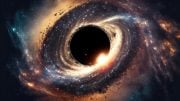
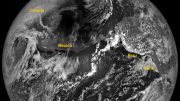




It’s coming for us! RUN!!